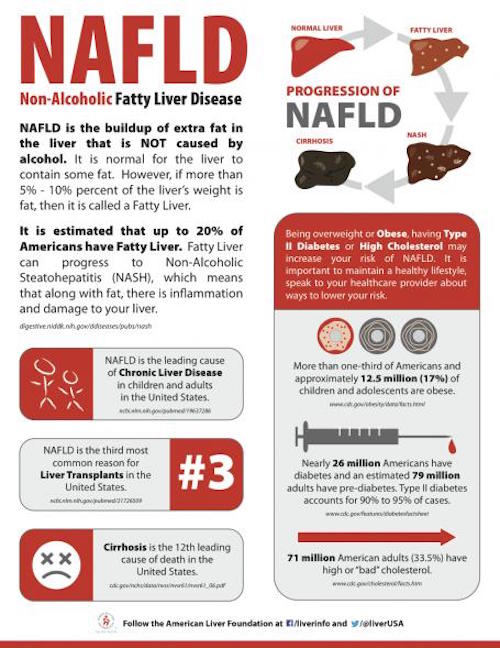Editor’s Note: This website is not designed to, and should not be construed to, provide medical advice, professional diagnosis, opinion or treatment to you or any other individual, and is not intended as a substitute for medical or professional care and treatment. For serious.
~
We might dismiss liver disease as alcohol-related, yet studies find an increase in non-alcoholic fatty liver disease (NAFLD).
The culprit? The 152 pounds of sugar and 146 pounds of flour the average American eats every year.
The most common disease—NAFLD—affects 90 million Americans, many of whom don’t know they have it, and creates a major risk factor for diabetes, heart attacks and even cancer.
As its name implies, our liver becomes full of fat, creating inflammation and paving the road for chronic disease.
Fatty liver occurs when our liver turns sugar into a fat-production factory in a process called lipogenesis. Fructose, the most metabolically damaging sugar, actually ramps up the lipogenesis response.
High-fructose corn syrup found in our processed foods, including soda, is the single biggest cause of fatty liver.
Blood tests or an ultrasound can both detect if we have a fatty liver. Abnormal results signify big trouble, but even if our test comes back normal, a liver function test doesn’t always detect a fatty liver. An ultrasound can be more sensitive.
How do we know if we have a fatty liver? If we eat a lot of sugar and flour, if we have a little bit of belly fat, or constantly crave carbs, starch and sugar, we probably do.
Fatty liver creates a whole cascade of issues, including inflammation, which creates insulin resistance and pre-diabetes. Our body deposits fat in our liver and around our organs and in our belly.
That dangerous belly fat caused by the sugar and starch then creates even more problems, including high triglycerides, low HDL (“good” cholesterol) and small LDL (“bad cholesterol). Having a fatty liver puts us at great risk for having a heart attack.
Certain populations like Latin Americans have a much higher risk of having a fatty liver. Shockingly, we see 12-year-old boys who consumed soda for years needing liver transplants from fatty liver. That’s pretty scary, and we really need to think about what we are doing to our children by feeding them these toxic substances.
We don’t want to end up with a liver transplant. We don’t want to end up needing medications to fix the complications of a fatty liver like high blood pressure, diabetes, heart disease and abnormal cholesterol. We want to get to the root of the problem.
Fortunately, these simple diet, exercise and supplement modifications can help heal fatty liver:
- Cut out all high fructose corn syrup from our diet. If we see it on any label for any product—whether it’s a salad dressing or ketchup or tomato sauce—don’t eat it. Think about it: most servings of tomato sauce that we buy in a jar have more sugar than a serving of Oreo cookies. Get completely rid of all that high-fructose corn syrup from our diet.
- Reduce or eliminate starch. Get rid of white, processed flour. Even whole grain flours can be a problem. It’s common to find too much of these starchy foods in the classic American diet, or what we call Standard American Diet (SAD, indeed). All those things will promote a fatty liver. We may be surprised to learn that it’s actually not fat that causes a fatty liver. It’s sugar.
- Add some good things to our diet to help heal fatty liver. Add plenty of fruit, vegetables, nuts and seeds. Add lean animal protein like chicken and fish. Add good oils like olive oil, macadamia nut oil, avocados, coconut butter and fish oil. Good fats like these are anti-inflammatory and they help repair our liver.
- Improve metabolism through exercise. This is a fabulous way to improve insulin resistance and reduce fatty liver.
- Use the right supplements. For patients with fatty liver, we give them herbs like Milk Thistle. We use things like lipoic acid, a powerful antioxidant, and N-acetylcysteine. These things help boost something in our liver called glutathione. And we use other things like B vitamins and magnesium. All these things will help our liver repair and heal.
- Eat detoxifying liver-repairing super foods. Focus on the broccoli family, including kale, collards, cabbage, Brussels sprouts, broccoli, arugula and daikon radish, which help repair and heal our liver. Garlic and onions are also full of sulfur, which is a great detoxifier.
A healthy liver helps us deal with all the junk and chemicals in our environment. When we have a healthy liver, our body stays healthy, we don’t get sick and we can feel good.
Are you concerned you may be at risk for fatty liver? Have you been diagnosed? What have you tried that has helped you? Or what hasn’t worked? Share your thoughts below or on my Facebook fan page.
~
References
Basaranoglu M, et al. Fructose as a key player in the development of fatty liver disease. World J Gastroenterol. 2013 Feb 28;19(8):1166-72.
Merrell MD, et al. Drug metabolism alterations in nonalcoholic fatty liver disease. Drug Metab Rev. 2011 Aug;43(3):317-34.
Vos MB, et al. Dietary fructose in nonalcoholic fatty liver disease. Hepatology. 2013 Jun;57(6):2525-31.
http://www.usda.gov/factbook/chapter2.pdf
~
Relephant Read:
A Nutrition Myth that Keeps us Fat, Sick & Tired.
~
Author: Mark Hyman
Editor: Rachel Nussbaum
Photo: The American Liver Foundation







Read 1 comment and reply